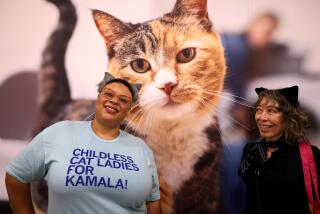Let us not be catty about the ‘pet of the ‘80s’ . . . Some of us humans share its three interests
- Share via
It has been almost two years now since Mona had a litter of four kittens beside our front porch, and we were feeding not only all of them but also their older siblings, from her previous litters.
At the high-water mark of this charity, we were feeding from nine to 12 cats a day. They called regularly for their handouts, morning and evening.
They were wild. They would not allow themselves to be petted or picked up, and they would not come into the house. I had the humane idea that I would have them caught, one by one, and neutered, thus interrupting their wanton breeding. We did succeed in catching four or five, but the others were too wily.
Of that lot only one remains as a regular. Two or three show up as occasionals. Even Mona comes by now and then, but she has her litters somewhere else.
I don’t know what has happened to the others; whether they have found other homes, or whether they have fallen to the terrible attrition of the streets. Some undoubtedly have been hit by cars; some probably have been deliberately murdered; and some have been taken by coyotes, for indeed there be coyotes here.
Our only regular now is one of the four kittens, a dark sable-colored cat my wife favored; she calls her Sable. She is one of the females we caught and had spayed. She lives in our backyard and feeds from a dish on the top of our patio table; she won’t come in. My wife can stroke her now while she’s feeding her, but Sable doesn’t respond to this comforting and does not seek it out.
She is utterly dependent on us, yet she remains her wild lone, in Kipling’s phrase. It is interesting that whenever Mona comes around, Sable defers to her mother, and backs away from her dish until mother has had her fill.
Though I can’t think of a thing she gives us in return, this small wild cat has intruded herself into my wife’s routine. She must be thought of, and planned for; whenever we go to the market we must remember to pick up cat food. If we go out of town on holiday we must make sure that some neighbor feeds her.
What is this strange hold that cats have over American homeowners?
I have found a kindred spirit in Penny Ward Moser, author of “The Curse of the Little Round Cans,” in the September issue of Discover.
Her first paragraph rings a bell:
“I was in my tiny city kitchen when I realized it had all gone wrong. It was a night like any other. I was feeding my cats something better than I was feeding my husband. We were having plain chicken with rice. The cats, however, would be having Savory Stew, a meat and vegetable dish in a wonderful caramel-colored gravy. Out dinner would run 79 cents a pound, the cats’ $1.18. What’s more, if my husband didn’t like his dinner, he’d still love me. But if the cats found something unsavory in their stew, they’d yowl, break things, and maybe pee in my shoe. . . .”
Is that not a familiar scene? How many husbands, I wonder, suspect that their cats are getting better board than they are?
Like most of us, Penny Ward Moser never meant to have a cat in the city. She was a farm girl, and the only cats she had known were barn cats. “They hunted rodents, and if they caught them they ate them, because they were hungry. . . .”
Moser acquired her first cat the way most people do: “One day when the back door was left open, a cat walked in.”
The point of Moser’s article is that about 48 million cats now live in more than 27 million households--10 million more cats and 8 million more households than just five years ago. The cat is the “pet of the ‘80s.”
“This sudden infatuation is hard to explain,” she says, “since it has always seemed to me that cats only occupy space and think about three things: food, sex, and nothing. If they’re neutered, that leaves food.”
As a result of their popularity, she points out, an enormous industry has sprung up to feed these indigents; it employs corps of expensive scientists to find out, by experimenting with 2,700 test-kitchen cats, what pleases kitty’s palate most, and it employs security staffs to protect its secrets from competitors. It’s a $2-billion business.
The cat is a pure predator. It is one of nature’s true carnivores. As Moser says, “What a cat needs to live is animal tissue.”
Then why not let them catch mice and be done with it? Actually, scientists in the employ of the cat food industry have found that cats prefer canned cat food to rodents, and every American cat owner seems determined to spoil his cat.
On our shelves at this moment we have two cans of tuna for humans. The label says, “Fancy albcore, solid white tuna in spring water.”
We also have half a dozen cans of tuna for the cat. The labels says, “Tuna, water, tricalcium phosphate, vitamin supplement A, D3, E; choline chloride, iron sulfate, potassium chloride, zinc oxide, niacin, sodium selenite, thiamine mononitrate, calcium pantothenate, menadione sodium bisulfite complex (source of Vitamin K) manganous oxide, riboflavin supplement, copper oxide, pyridoxine hydrochloride, biotin, folic acid, ethylene diamine dihydriodide (source of iodine).”
I think about food, sex and nothing, too; but I have no evil designs on my wife’s shoe.






